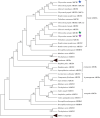ABCB transporters in a leaf beetle respond to sequestered plant toxins
- PMID: 32873204
- PMCID: PMC7542790
- DOI: 10.1098/rspb.2020.1311
ABCB transporters in a leaf beetle respond to sequestered plant toxins
Abstract
Phytophagous insects can tolerate and detoxify toxic compounds present in their host plants and have evolved intricate adaptations to this end. Some insects even sequester the toxins for their defence. This necessitates specific mechanisms, especially carrier proteins that regulate uptake and transport to specific storage sites or protect sensitive tissues from noxious compounds. We identified three ATP-binding cassette subfamily B (ABCB) transporters from the transcriptome of the cardenolide-sequestering leaf beetle Chrysochus auratus and analysed their functional role in the sequestration process. These were heterologously expressed and tested for their ability to interact with various potential substrates: verapamil (standard ABCB substrate), the cardenolides digoxin (commonly used), cymarin (present in the species's host plant) and calotropin (present in the ancestral host plants). Verapamil stimulated all three ABCBs and each was activated by at least one cardenolide, however, they differed as to which they were activated by. While the expression of the most versatile transporter fits with a protective role in the blood-brain barrier, the one specific for cymarin shows an extreme abundance in the elytra, coinciding with the location of the defensive glands. Our data thus suggest a key role of ABCBs in the transport network needed for cardenolide sequestration.
Keywords: ABCB transporters; Chrysochus; cardenolides; multidrug resistance; sequestration; tissue-specific expression.
Conflict of interest statement
We declare we have no competing interests.
Figures




Similar articles
-
Tissue-specific transcript profiling for ABC transporters in the sequestering larvae of the phytophagous leaf beetle Chrysomela populi.PLoS One. 2014 Jun 2;9(6):e98637. doi: 10.1371/journal.pone.0098637. eCollection 2014. PLoS One. 2014. PMID: 24887102 Free PMC article.
-
Substrate Specificity of ABCB Transporters Predicted by Docking Simulations Can Be Confirmed by Experimental Tests.Molecules. 2024 Nov 7;29(22):5272. doi: 10.3390/molecules29225272. Molecules. 2024. PMID: 39598661 Free PMC article.
-
Na+/K+-ATPase resistance and cardenolide sequestration: basal adaptations to host plant toxins in the milkweed bugs (Hemiptera: Lygaeidae: Lygaeinae).Proc Biol Sci. 2015 Apr 22;282(1805):20142346. doi: 10.1098/rspb.2014.2346. Proc Biol Sci. 2015. PMID: 25808891 Free PMC article.
-
ABCB transporters: functionality extends to more than auxin transportation.Planta. 2025 Mar 18;261(4):93. doi: 10.1007/s00425-025-04662-9. Planta. 2025. PMID: 40100293 Review.
-
A Critical View on ABC Transporters and Their Interacting Partners in Auxin Transport.Plant Cell Physiol. 2017 Oct 1;58(10):1601-1614. doi: 10.1093/pcp/pcx104. Plant Cell Physiol. 2017. PMID: 29016918 Review.
Cited by
-
Fecal Deployment: An Alternative Way of Defensive Host Plant Cardenolide Use by Lilioceris merdigera Larvae.J Chem Ecol. 2024 Feb;50(1-2):63-70. doi: 10.1007/s10886-023-01465-8. Epub 2023 Dec 7. J Chem Ecol. 2024. PMID: 38062246 Free PMC article.
-
No-cost meals might not exist for insects feeding on toxic plants.Biol Open. 2023 Jun 15;12(6):bio059800. doi: 10.1242/bio.059800. Epub 2023 Jun 14. Biol Open. 2023. PMID: 37314183 Free PMC article. Review.
-
ABCB1 and ABCG2 Regulation at the Blood-Brain Barrier: Potential New Targets to Improve Brain Drug Delivery.Pharmacol Rev. 2023 Sep;75(5):815-853. doi: 10.1124/pharmrev.120.000025. Epub 2023 Mar 27. Pharmacol Rev. 2023. PMID: 36973040 Free PMC article. Review.
-
Rapid and Selective Absorption of Plant Defense Compounds From the Gut of a Sequestering Insect.Front Physiol. 2022 Mar 3;13:846732. doi: 10.3389/fphys.2022.846732. eCollection 2022. Front Physiol. 2022. PMID: 35309070 Free PMC article.
-
Metabolization and sequestration of plant specialized metabolites in insect herbivores: Current and emerging approaches.Front Physiol. 2022 Sep 27;13:1001032. doi: 10.3389/fphys.2022.1001032. eCollection 2022. Front Physiol. 2022. PMID: 36237530 Free PMC article. Review.
References
-
- Duffey SS. 1980. Sequestration of plant natural products by insects. Annu. Rev. Entomol. 25, 447–477. (10.1146/annurev.en.25.010180.002311) - DOI
-
- Opitz SEW, Müller C. 2009. Plant chemistry and insect sequestration. Chemoecology 19, 117.
-
- Bowers MD. 1992. The evolution of unpalatability and the cost of chemical defense in insects. In Insect chemical ecology: an evolutionary approach (eds Roitberg BD, Isman MB), pp. 216–244. New York, NY: Chapman & Hall.
Publication types
MeSH terms
Substances
Associated data
LinkOut - more resources
Full Text Sources

